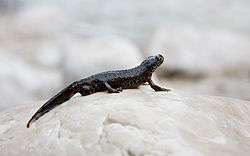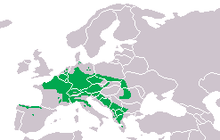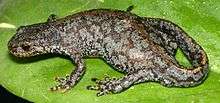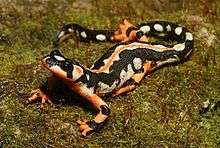Alpine newt
| Alpine newt | |
|---|---|
 | |
| A male alpine newt | |
| Scientific classification | |
| Kingdom: | Animalia |
| Phylum: | Chordata |
| Class: | Amphibia |
| Order: | Urodela |
| Family: | Salamandridae |
| Genus: | Ichthyosaura Latreille, 1801 |
| Species: | I. alpestris |
| Binomial name | |
| Ichthyosaura alpestris (Laurenti, 1768) | |
 | |
| Synonyms | |
The alpine newt (Ichthyosaura alpestris) is a newt of the salamander order Caudata (or Urodela) in the class of amphibians. It was formerly known as Triturus alpestris and Mesotriton alpestris.
Description

During the mating season early in the year, the males exhibit dark-blue colouring on their backs; their flanks have white-black-spotted stripes below sky-blue stripes, and their bellies are bright orange. The females, in water camouflage, are mottled brown and have some weak spotting on their backs. The biggest of the males can reach up to 9 cm, and the females up to 12 cm in length. After the mating season, they return their original colour of mottled brown.
Life and habitat
Alpine newts typically inhabit forests with good access to water in hilly to mountainous regions. They are mostly absent in forest-poor areas. They populate well in thick deciduous forests, as well as parkland and natural gardens. Outside the spawning season, Alpine newts live terrestrially. During the day it then stays in all kinds of undergrowth. After the adults come out of winter dormancy, they migrate to their spawning pools (forest pools, artificial pools) and live the mating season in cool water.
Distribution
Alpine newts were originally confined to Central Europe and mountainous Southern Europe,[2] as well as having isolated populations on the northern Iberian Peninsula and in Italy.[1] The species was introduced into the United Kingdom in the 1930s, initially in southern England and since then several populations have become established as far north as Edinburgh.[3] It has also been introduced to the Sierra de Guadarrama in Madrid Province Spain.[1]
Taxonomy

The alpine newt was formerly placed within the genus Triturus. García-París et al.[4] divided the genus Triturus, placing the alpine newt into its own genus Mesotriton. Later, Mesotriton was postulated to be a junior synonym of Ichthyosaura.[5] Ten subspecies of the alpine newt are recognized (some only with neotenic forms):
- I. a. alpestris (Laurenti, 1768) alpine newt
- I. a. apuanus (Gray, 1850) Italian alpine newt
- I. a. cyreni (Mertens & Muller, 1940) Spanish alpine newt
- I. a. inexpectatus (Dubois & Breuil, 1983) Calabrian alpine newt
- I. a. lacusnigri (Dely, 1960) Yugoslavian alpine newt
- I. a. montenegrinus (Radovanovic, 1951) Montenegran alpine newt
- I. a. piperianus (Radovanovic, 1961)
- I. a. reiseri (Schreiber, 1912) Bosnian alpine newt
- I. a. serdarus (Radovanovic, 1961)
- I. a. veluchiensis (Wolterstorff, 1935) Greek alpine newt
I. alpestris is the only living species of the genus Ichthyosaura, though one extinct species, I. randeckensis, has also been referred to this genus.[6]
References
- 1 2 3 Jan Willem Arntzen; Mathieu Denoël; Sergius Kuzmin; et al. (2009). "Ichthyosaura alpestris (Alpine Newt)". The IUCN Red List of Endangered Species. International Union for Conservation of Nature and Natural Resources. Retrieved 27 February 2017.
- ↑ "Alpine Newt". Froglife. Retrieved 27 February 2017.
- ↑ "Alpine newt". Lothian Amphibian and Reptile Group. Retrieved 27 February 2017.
- ↑ García-París, M., A. Montori, and P. Herrero. 2004. Amphibia: Lissamphibia. Fauna Iberica Vol. 24. Madrid: Museo Nacional de Ciencias Naturales and Consejo Superior de Investigaciones Científicas.
- ↑ Josef F. Schmidtler. 2007. Die Wurzeln einer bayrischen Herpetofaunistik im 18. und beginnenden 19. Jahrhundert. Zeitschrift f. Feldherpetologie 14: 93–119. Laurenti, Bielefeld. (PDF online, in German; see page 105)
- ↑ Schoch, R. R.; Rasser, M. W. (2013). "A new salamandrid from the Miocene Randeck Maar, Germany". Journal of Vertebrate Paleontology. 33: 58. doi:10.1080/02724634.2012.716113.
External links

- Amphibiaweb: Ichthyosaura alpestris
- Amphibian Species of the World

